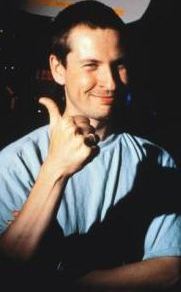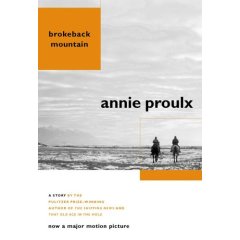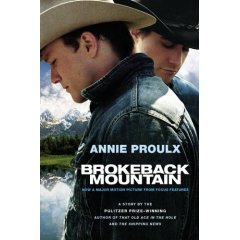To differentiate 2001 from the “flying saucer pictures” that owned the sci-fi genre at the time, Stanley Kubrick planned to begin the movie by showing interviews with 21 real-world scientists about their predictions for the future and the likelihood of extra-terrestrial life.
This prologue was dropped for length, and the footage has yet to be located, but recently discovered transcripts of the interviews will be published next month in the UK. The Independent reports that Carl Sagan was on the list to be interviewed, but was cut when he demanded editorial control and a percentage of the gross. millions and millions.
2001: The secrets of Kubrick’s classic [independent.co.uk via…um]
Are We Alone?: The Stanley Kubrick Extraterrestrial Intelligence Interviews [amazon.co.uk]
Category: making movies
On The Apprentice


So I was stoking the fires of ill will against Martha Stewart by watching the last half hour of The Apprentice, and I’m thinking, “Damn, but that woman bugs the crap out of me,” and “DAY-UM, but I hate the artificial claptrap of reality TV.” And then I decide to clear my Netflix queue by finally watching The Five Obstructions, and damned if it isn’t The Apprentice – The Lars von Trier Edition.
It’s got everything I hate to hate about reality TV: a smug, annoying, self-annointed omnipotent pseudo-god forcing a supplicant to jump through ridiculous, contrived hoops. Von Trier achieves something I never thought possible: he’s actually more annoying and passive aggressive a control freak than Stewart. [I guess Nicole Kidman and Bjork could’ve told me that; I’ll have to bring it up next time I see them.]
The twist in The Five Obstructions, of course, is that von Trier himself IS the apprentice. His mentor/inspiration/victim is the elder Danish director Jorgen Leth, who must remake his 1967 short film, The Perfect Human five times, each time acceding to von Trier’s intentionally capricious constraints [a cartoon, shot in the most miserable place on earth, no edit over 12 frames, etc.].
And just because Lars is more honest than Martha–in the end, he cops to the fact that, yeah, it IS all about him, always was–it doesn’t mean he’s any less unpleasant.
Show Me Some Penguins, Pierre
It’s supposed to keep raining through Friday, when artist Pierre Huyghe is planning to shoot an element of a new video art work in Central Park’s Wollman Rink. Huyghe is transforming the rink into a black ice floe, home for an albino penguin, apparently, and also to a 42-piece orchestra.
The public is invited to come and participate as audience/extras during three run-throughs of the piece. Even as he held out the possibility of some kind of surprise ending, Huyghe tried to manage expectations about the performance/shoot. He told Randy Kennedy of the NYT, “‘There will be no crazy dancing girls,’ he stressed. ‘In fact, there will be almost nothing – for all 20 minutes.'”
Listen, I know the guy schlepped to Antarctica for a month searching for some damn albino penguin; thanks. But if we’re gonna sit in the rain for two hours watching “almost nothing,” we better damn well see some penguins. And I’ll incite the crowd to storm the zoo if I have to.
An Antarctica Sighting in Central Park [nyt]
Shlog-Hinten Mountain
So the new year’s not starting off that great. I found this great vintage Jewish cowboy belt buckle on ebay…
Beautiful old belt buckle has nice detail. Features the Star of David. It is intricately worked in sterling silver. The buckle is marked Plata de Jalisco .925 V.H.L.C. Guad. Mex. and also has the number 43 on the back buckle. This buckle measures aprox. 3.5″ long by 2.” Take a look. Nice from estate. Prominent Jewish family on Chicago’s north shore whom enjoyed Western style attire…ordered shirts, belts, shoes and other items from Porters Cowboy Store/Catalog Pheonix, AZ…
…but I just lost it at the last second to a hardcore Westernwear collector.
See, I wanted it for a Yiddish remake of Brokeback Mountain and uh, well, never mind. Back to the drawing board.
Previously: So You Want To Read “Brokeback Mountain”
Belt buckles I DID buy once for a movie crew
Penguin Filmmakers Behaving Badly
Dateline, Paris [of course]:
In Hollywood, meanwhile, the jockeying for credit on March of the Penguins was taking place. Last month, Jordan Roberts, a film director turned writer, claimed credit in a Los Angeles Times article for essentially “re-envisioning” the film by writing the narration and substituting a new soundtrack.
Mr. Jacquet scoffs at that view. “There are millions of people around the planet who like the French version, my version,” he said with a laugh. And like the penguin stars of the movie, Mr. Jacquet has never met Mr. Roberts.
Of course, the ones that saw Roberts’ reworking of your treacly Look Who’s Talking! version have been stuffing $71 million down your gullet, Mr. Jacquet.
Compared With Their Filmmakers, the Penguins Have It Easy [nyt]
So You Want To Read “Brokeback Mountain”
I shouldn’t be surprised that I’m getting this question a lot these days. Here’s what Ang Lee told the NYT’s Karen Durbin:
“When I first read the story, it gripped me. It’s a great American love story, told in a way that felt as if it had never been done before. I had tears in my eyes at the end. You remember? You see the shirts put away in the closet side by side.”
Who could forget? When Annie Proulx’s short story about two cowboys in love appeared in The New Yorker nearly eight years ago, it was so startling and powerful that for many people, the experience of reading it remains a vivid, almost physical memory.
The movie just won the Golden Lion at the Venice Film Festival, and had its North American debut at the Toronto Festival last week. The theatrical release is expected in December, which gives you enough time to track down a copy of Brokeback Mountain yourself.


Here’s where it is:
Here’s where it isn’t:
A slightly bowdlerized version of the text was posted last summer on a message board at heathbaby.com, but has since been taken down. If you try Googling a distinctive phrase [like, say, “They shook hands in the choky little trailer office,”] you might find it, though. [unbelievable-but-true update via towleroad: Amazon published the complete story as an excerpt for an out-of-print audio version of Close Range.]
And just like that, his dream of amassing a mountain of quarters from Amazon commissions burns off like morning dew on the alfalfa field.
Ang Lee: Master of Social Mores [nyt via iht]
Official filmsite: Brokebackmountain.com
Donald Sutherland Naked On A Cold Day
I’m not the only one with a thing for the editing. Donald Sutherland tells the Guardian about what made that sex scene in Don’t Look Now so, well, sexy. Hint: it wasn’t Julie Christie. OK, it wasn’t JUST Julia Christie:
“About Don’t Look Now, we shot that love scene in a room in the Bauer Grunwald early one morning with Nick Roeg and Tony Richmond operating two un-blimped Arriflex cameras and a bunch of wires going to the technicians on the other side of the closed door. An un-blimped Arri makes a noise like a huge sewing machine. Two of them operating together are deafening. Julie and I lay side by side on the bed, Nick yelled instructions. ‘ZZZZZZZ Donald, kiss Julie’s breast, ZZZZZZZZZZZ Julie, tilt your head back ZZZZZZZZZZZZZ Julie, come ZZZZZZZZZZZZZZ. That’s how it was for about three hours. What made the scene wonderful to people was the editing.
He goes on to tell why, and he’s right. But now I wonder when the sound editor gets his due.
Total Recall [guardian.co.uk, all the way down]
Editing, Art or Science? Movie or Website.
I find that I remake a movie at least three times: when I write it, when I shoot it, and again when I edit it. The one I didn’t realize–and that still seems wildly underappreciated to me–is editing.
Well, here’s hoping that EdgeCodes.com has a long, successful run at Two Boots Theater and beyond. From A.O. Scott’s review, this documentary about the history, theory, practice, art, and science of film editing sounds awesome.
Inside the Editing Room, Where Movies Are Built [nyt]
EdgeCodes.com [the name is the url!]
related: start with anything about Murch or Schoonmaker
Q: One Sheets To Get A Documentary Rolling
Turning from the descent of our country into unaccountable, repressive totalitarianism for a moment…
A reader emailed a question that I thought would be interesting to open up to other readers, too. He’s preparing to make a documentary on a band:
So now as I approach this project, which I intend to direct and shoot primarily myself, I am having trouble organizing my thoughts into the right style treatment for something of this nature. I am aiming for a “one sheet” that gets the point across and will be easy for the band/record company to read and comprehend. Do you have an example of something like this or know where I could go to find one? I would just love to get some ideas on how to format this thing.
Examples, not advice, necessarily, although I’m sure good advice/experiences would not be unhelpful. Send them in or point to them, and I’ll post the results here.
I’ve heard from TV show-pitching friends that people now want to see pilots and trailers more than treatments, little DV sketches of what a show’d actually look like. It reminds me of the pitch for Team America World Police, which consisted of a Thunderbirds episode overdubbed by Matt Parker and Trey Stone; it got the point across and conveyed the essence of what the film would be [or, in this case, should’ve been].
Still, it’ll be easier to get a record exec to skim a one-page treatment than to pop in a dvd, so so far, my advice is netting zero.
Akinori Oishi’s Microfilms
 Regine links to several examples of Japanese graphic artist Akinori Oishi’s work, but my favorites are the micro films. Tiny loops formatted as animated gifs, they remind me of the best of the AIM buddy icon movies. These are older, though, from a pre-Euro Europe, around 2001.
Regine links to several examples of Japanese graphic artist Akinori Oishi’s work, but my favorites are the micro films. Tiny loops formatted as animated gifs, they remind me of the best of the AIM buddy icon movies. These are older, though, from a pre-Euro Europe, around 2001.
check out micro films by Akinori Oishi, also his blog [via WMMNA]
The Marketing Of The Penguins
If it’s any consolation, Japan looked like it had been plush carpetbombed by penguins, too.
WPS1’s Stephen Schaefer did an interview with Luc Jacquet, director of March of The Penguins, which was first broadcast on July 18th. [scroll down]
Beyond The Subtitles: Luc Jacquet Interview [wps1.org]
Strictly Murderball
Radar Online has a print-sized [i.e., too short] q&a with Murderball co-director Dana Adam Shapiro, but it’s mostly about his novel [The Every Boy] and his childhood. It’s interesting that filmmakers don’t get asked how autobiographical their work is as much as novelists do.
On A Roll [radaronline]
Meanwhile, Murderballer Mark Zupan talks to WPS1’s Stephen Schaefer as part of a cross-country, film-promoting, drink-a-thon, which he also blogs about on mtv.com. Zupan is like the wheelchair guy on Jackass, if Jackass had a wheelchair guy, so most of his schtick is about being such a badass.
Beyond The Subtitles: Mark Zupan Interview [wps1.org]
Rock & Roll, Mark Zupan’s blog [mtv.com]
Maybe They Should Read The Arts & Leisure Secion
The NYT Magazine has an excellent firsthand report from the set of Red vs. Blue. It turns out that a few scrappy creative types are actually making movies inside of video games. If this catches on, it could be revolutionary. I mean, it’s pretty funny to imagine those faceless soldiers in Halo having inner lives and existential crises. haha.
Now if only this upstart medium had a name…
8/05, 4,500 words: The X-Box Auteurs [nytmag]
Previously: Waiting for Halo; 11/04, like, 100 words: Virtual Warriors Have Feelings, Too [nyt]
What Ere Thou Art, Act Well Thy Part
O me of little faith. Richard Dutcher, the guy who made the first Mormon niche film, God’s Army, goes around making sure he’s referred to as “The Mormon Spielberg.” Meanwhile, the guys at HaleStorm seem to have set their sights on becoming “The Mormon Farrelly brothers,” I guess. But with their new film, Church Ball, as they try to break out of the Mormon ghetto they helped define–and saturate with mediocre comedies–I think they’re well on their way to earning the title, “The Mormon Rawson Marshall Thurber,” and they’re welcome to it.
From the NYT puff piece hailing The New Mormon Wave of fogettable cinema:
So far, the price of cultural crossover seemed to be merely good-natured exasperation. As the cameras rolled, an actor unspooled streams of profanity, and Hale had to assure his extras, all Mormon, that the four-letter words would be dubbed over with a ref’s whistle.
The Cinema of Latter-Day Saints [nyt mag]
Also in the NYT Mag: Jim Jarmusch shows how it’s actually done.
Related? A guy who went to high school with Napoleon Dynamite producer Jeremy Coon is trying to out-filmmake him before their 2007 reunion. Good luck with that.
“Films as Found Object”
Stefano Basilico’s well-rounded exhibition on artists’ use of films–not film–as a medium got a nice review from Roberta Smith in the NYT. My absolute favorite piece in the show–which was in Miami last winter–is Christian Marclay’s Video Quartet. But Pierre Huyghe’s smart, touching work, L’Ellipse also stands out for the way it toys with film’s conventions of time and narrative. Huyghe filmed a 10-minute walk across the Seine that was implied by an edit in Wim Wenders’ film, The American Friend. [Smith calls it a jump cut, which it’s technically not. True, the movie jumps from one side of the Seine to the other, but a jump cut is actually a break in time at the same spot or scene.]
A Medium In The Making [nyt]
CUT/ Film As Found Object, at Milwaukee Art Museum through Sept. 11 [mam
